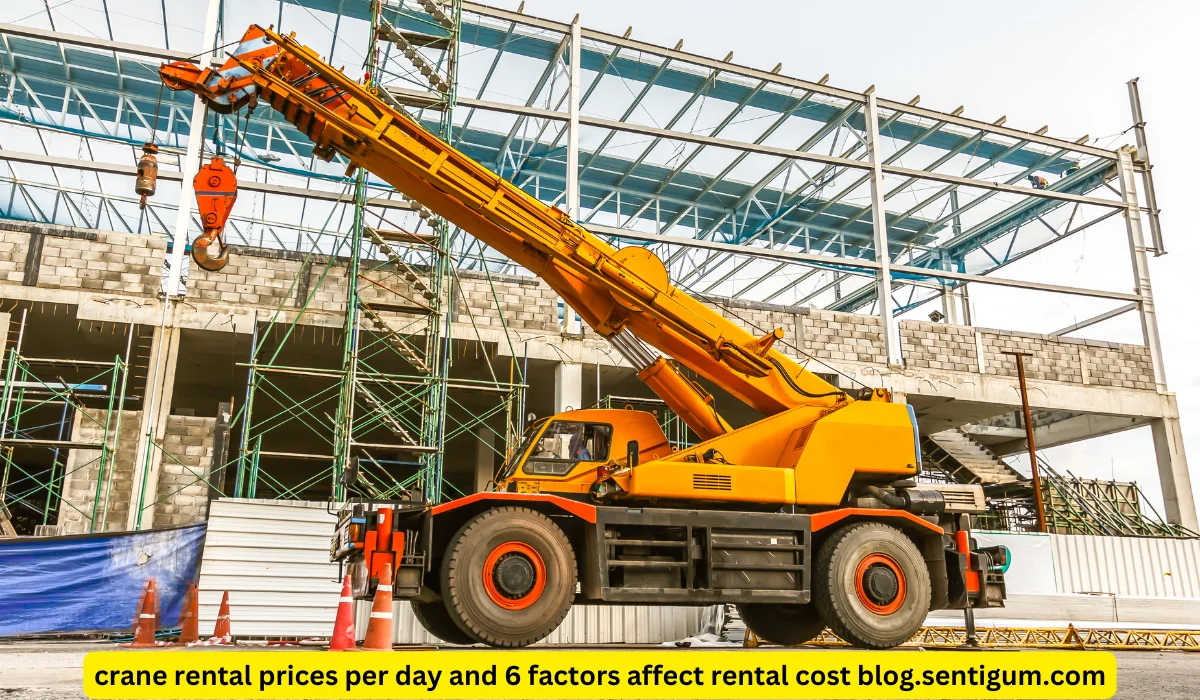When it comes to heavy construction projects, cranes play a crucial role in lifting and moving heavy materials, equipment, or structures. However, owning a crane can be a significant investment, especially for businesses that only require it for short-term projects. This is where crane rental services come in, offering an efficient and cost-effective solution for contractors. While renting a crane may seem straightforward, the cost can vary depending on several factors. In this article, we will explore crane rental prices per day and 6 factors affect rental cost blog.sentigum.com. By understanding these factors, businesses can make more informed decisions and optimize their project budgets.
Average Crane Rental Prices Per Day: An Overview
crane rental prices per day and 6 factors affect rental cost blog.sentigum.com can vary widely depending on the type and size of the crane required for the job. On average, crane rental rates can range from as low as $200 per day for smaller, less complex cranes to upwards of $1,000 per day for larger and more specialized cranes. However, these prices are subject to change based on several influencing factors such as the crane’s lifting capacity, the rental period, geographic location, and additional service requirements.
For example, smaller hydraulic cranes or truck-mounted cranes typically have lower rental costs due to their easier mobility and lower lifting capacity. On the other hand, larger cranes such as tower cranes or rough terrain cranes used for more complex, heavy-lifting tasks can command higher rental prices. It’s important to note that crane rental prices often include basic operational charges, but additional costs may arise depending on the project’s specific needs. Understanding these price variables can help contractors estimate the total rental cost more accurately.
Also Read: Arfraier Promo | Naz Tricks: A Comprehensive Guide
Factor 1: Crane Type and Size
The most significant factor influencing crane rental prices per day is the type and size of the crane being rented. Cranes come in various types, each suited to specific kinds of work, and the rental cost is usually proportional to the crane’s size, weight, and lifting capacity.
- Small Cranes: These cranes, such as truck-mounted cranes or mobile cranes, typically have a lower lifting capacity, usually up to 10 to 20 tons. Their mobility and smaller footprint make them suitable for short-term projects or confined spaces, and they generally come with lower rental rates.
- Medium-Sized Cranes: Cranes like all-terrain or rough terrain cranes, which are more versatile and have a lifting capacity of 50 to 100 tons, are commonly used on larger construction sites. They can be pricier, with rental costs ranging from $500 to $1,000 per day, depending on their specifications.
- Large Cranes: Tower cranes or crawler cranes, which are often used in large-scale projects such as skyscrapers or heavy infrastructure developments, are among the most expensive to rent. These cranes have high lifting capacities, often exceeding 200 tons, and their rental prices can reach thousands of dollars per day.
Choosing the appropriate crane for the task at hand is critical to optimizing both operational efficiency and rental costs. Renting a crane that is too large for the job may result in unnecessary expenses, while opting for a smaller crane could hinder productivity or safety if it’s unable to handle the required loads.
Factor 2: Rental Duration
Another crucial factor in determining crane rental prices per day is the length of the rental period. Typically, crane rental companies offer daily, weekly, or monthly rates, with longer rental periods often resulting in lower per-day costs. For instance, renting a crane for an extended period, such as a month, may come with a discounted rate compared to a one-day rental.
In many cases, contractors can negotiate more favorable rates if they commit to renting the crane for a longer duration. Short-term rentals, on the other hand, are generally more expensive on a per-day basis because the company must account for the time spent delivering, setting up, and eventually dismantling the crane. Planning your project timeline carefully and renting a crane for the appropriate amount of time can help minimize rental costs while ensuring that the crane is available when needed.
Factor 3: Location and Transportation Costs
Geographic location plays a significant role in crane rental prices per day, as transportation and logistical costs vary from region to region. The farther the crane needs to travel to reach the project site, the higher the transportation costs. If your project is located in a remote or hard-to-reach area, you may need to pay additional fees for transporting the crane to the site.
Additionally, crane rental costs tend to be higher in urban or densely populated areas where demand for cranes is greater, such as in large cities with active construction industries. On the other hand, rural areas may have lower rental rates but could incur higher transportation costs if the rental company is located far from the project site. To manage these costs effectively, consider renting from a company that is geographically close to your project, as this can help reduce both the transportation and setup fees.
Factor 4: Crane Operator and Crew Costs
Another important factor affecting crane rental prices per day is whether the rental includes an experienced crane operator or if you need to hire one separately. Many crane rental companies offer the option of providing an operator as part of the rental package. While this can increase the overall cost, it also ensures that the crane is operated by a skilled professional with the necessary certifications and experience to complete the job safely and efficiently.
If the rental company does not include an operator, you will need to factor in the additional cost of hiring a licensed crane operator, which can range from $50 to $150 per hour depending on the operator’s experience and the complexity of the job. Additionally, some larger projects may require a full crew, including riggers and signal persons, to safely manage the lifting and moving of materials. These crew costs can add to the daily rental price but are essential for ensuring the safety and success of the project.
Also Read: Desiremovies Space: A Comprehensive Guide | Drew Brees Makes His NBC Debut
Factor 5: Setup and Dismantling Costs
Crane setup and dismantling, also known as mobilization and demobilization, are crucial aspects that impact crane rental prices per day. For larger cranes such as tower cranes or crawler cranes, the setup process can be complex and time-consuming, often requiring a team of workers, specialized equipment, and additional vehicles for transportation.
The cost of setting up and dismantling a crane varies depending on the size and type of the crane as well as the complexity of the job site. Setup and dismantling costs can range from a few hundred dollars for smaller mobile cranes to thousands of dollars for larger cranes. This is an important factor to consider when estimating the overall cost of crane rental, especially for short-term projects where the setup and dismantling process can represent a significant portion of the rental expense.
Factor 6: Additional Equipment and Permits
Depending on the nature of the project, you may need additional equipment or permits, both of which can impact crane rental prices per day. For example, certain jobs may require additional attachments for the crane, such as specialized hooks, booms, or slings, which may come at an extra cost. In some cases, particularly in urban areas or public spaces, you may also need to secure permits for operating the crane, blocking roads, or ensuring compliance with local regulations.
Permit costs vary depending on the location and type of work being performed, but failing to obtain the necessary permits can result in costly fines or project delays. Before renting a crane, it’s important to check with local authorities to determine what permits are required and factor these expenses into your budget. Additionally, coordinating with the rental company to ensure that all necessary equipment is included in the rental package can help avoid unexpected costs during the project.
Conclusion
In conclusion, crane rental prices per day and 6 factors affect rental cost blog.sentigum.com, ranging from the type and size of the crane to the rental duration, location, and additional service requirements. By understanding these six key factors—crane type, rental duration, transportation, operator costs, setup and dismantling fees, and additional equipment or permits—contractors and project managers can make more informed decisions when budgeting for crane rental services. Planning ahead, negotiating favorable terms, and choosing the right crane for your project’s specific needs can help optimize costs and ensure the success of your construction or industrial project.
Also Read: Leigh-Anne Csuhany Biography | Chatingly: Your Go-To Messaging App





